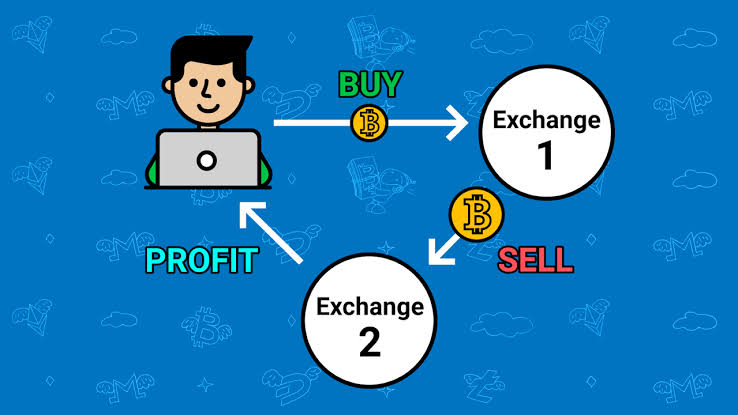Introduction

In the rapidly changing space of cryptocurrency, traders are always searching for fresh approaches that would increase their profits. One such way that has attracted significant interest is Crypto Arbitrage. This means it is a strategy of exploiting differences in prices of the same asset on various platforms. Traders can expect to make ‘riskless’ gains by purchasing low at one exchange and selling high on another. However, this concept may be easy to grasp theoretically but executing crypto arbitrage strategy successfully requires a good knowledge of the market, fast thinking and access to proper tools.
What is Crypto Arbitrage?
In this complete guide we will look into what crypto arbitrate is all about; how it works, types of arbitrages available, the risks as well as how you can maximize your returns. For both experienced trades and newbies in digital currencies, this post will provide all necessary information needed when trading with any form of cryptocurrencies.

Crypto Arbitrage refers to the exercise of purchasing a cryptocurrency on one exchange where the charge is decrease and simultaneously promoting it on every other alternate wherein the fee is higher. The distinction between the buy and promote expenses is referred to as the arbitrage spread, and it represents the trader’s earnings.
The key to a success arbitrage buying and selling lies inside the pace of execution. Cryptocurrency markets are extraordinarily volatile, and charge discrepancies can disappear inside seconds. Therefore, buyers need that allows you to execute transactions fast to take gain of these possibilities.
How Crypto Arbitrage Works

Crypto arbitrage takes advantage of the fact that different exchanges can have varying prices for the same cryptocurrency. These price differences can occur due to several factors, including:
- Liquidity: Exchanges with higher liquidity tend to have more stable prices, while smaller, less liquid exchanges may experience greater price fluctuations.
- Geographic Differences: Prices can vary based on the geographical location of an exchange. For example, during periods of high demand in a specific region, the price of a cryptocurrency may be higher on exchanges that cater to that region.
- Market Inefficiencies: Cryptocurrency markets are still relatively young and inefficient compared to traditional financial markets. This inefficiency can lead to temporary price discrepancies
Types of Crypto Arbitrage
There are several types of crypto arbitrage strategies that traders can use to capitalize on price discrepancies. Below are the most common ones:

- Spatial Arbitrage
Spatial arbitrage, also known as exchange arbitrage, involves buying a cryptocurrency on one exchange and selling it on another exchange where the price is higher. This is the most straightforward form of arbitrage and requires accounts on multiple exchanges to execute.
For example, if Bitcoin is priced at $50,000 on Exchange A and $50,500 on Exchange B, a trader could buy Bitcoin on Exchange A and immediately sell it on Exchange B for a $500 profit, minus transaction fees.
- Triangular Arbitrage
Triangular arbitrage involves three different cryptocurrencies and takes place within a single exchange. This strategy capitalizes on discrepancies in the exchange rates between three different cryptocurrencies.
For example, suppose you start with Bitcoin (BTC). You could convert BTC to Ethereum (ETH), then ETH to Litecoin (LTC), and finally LTC back to BTC. If there is a price discrepancy between these pairs, you could end up with more BTC than you started with, resulting in a profit.
- Statistical Arbitrage
Statistical arbitrage uses complex algorithms and statistical models to identify and exploit temporary price differences between cryptocurrencies. This strategy often involves high-frequency trading (HFT) and requires advanced technology to execute trades at lightning speed.
In this approach, the trader relies on quantitative data and past price movements to predict future price disparities. Due to its complexity, statistical arbitrage is typically used by institutional investors and experienced traders.
- Cross-Border Arbitrage
Cross-border arbitrage takes advantage of price differences between exchanges located in different countries. This type of arbitrage can be lucrative in regions with strict capital controls or where there is a significant difference in demand for a particular cryptocurrency.
For example, during periods of high inflation or political instability, the price of Bitcoin may be significantly higher on exchanges in countries like Argentina or Venezuela. Traders can buy Bitcoin on international exchanges and sell it on local exchanges for a profit.
Tools for Crypto Arbitrage

Successful crypto arbitrage requires access to the right tools and resources. Below are some essential tools that can help you identify and execute arbitrage opportunities:
- Arbitrage Bots
Arbitrage bots are automated trading software that can monitor multiple exchanges and execute trades in real time. These bots are particularly useful for high-frequency trading strategies, where speed is critical. Some popular arbitrage bots include:
- HaasBot: Known for its customization options and advanced features.
- Gimmer: Offers a user-friendly interface and supports multiple exchanges.
- Cryptohopper: Provides cloud-based trading with arbitrage features.
- Price Tracking Tools
Price tracking tools allow you to monitor the prices of cryptocurrencies across different exchanges. These tools can help you quickly identify arbitrage opportunities. Some popular options include:
- CoinMarketCap: Offers real-time price tracking and historical data for thousands of cryptocurrencies.
- CoinGecko: Provides detailed price information, including volume, market cap, and price charts.
- ArbitrageScanner: Specifically designed for crypto arbitrage, this tool scans multiple exchanges for price differences.
- API Integration
Many exchanges offer APIs (Application Programming Interfaces) that allow traders to connect their bots and trading software directly to the exchange. This enables faster execution of trades and access to real-time data
Risks of Crypto Arbitrage
While crypto arbitrage can be profitable, it is not without risks. Below are some of the most common risks associated with arbitrage trading:

- Transaction Fees
Every time you buy or sell a cryptocurrency, you incur transaction fees. These fees can vary widely between exchanges and can eat into your profits. It’s essential to factor in these costs when calculating potential arbitrage gains. - Slippage
Slippage occurs when the price of a cryptocurrency changes between the time you place an order and the time it’s executed. In fast-moving markets, slippage can significantly reduce or even eliminate your profit margin. - Withdrawal and Deposit Delays
Transferring funds between exchanges can take time, especially if you are dealing with large amounts. Delays in withdrawals or deposits can cause you to miss out on arbitrage opportunities or expose you to price fluctuations. - Exchange Risk
Exchanges can experience outages, security breaches, or liquidity issues, all of which can impact your ability to execute trades. It’s important to use reputable exchanges and diversify your trading activities across multiple platforms. - Regulatory Risks
Cryptocurrency regulations vary by country and can change fleetly. Regulatory actions, such as bans on certain exchanges or cryptocurrencies, can affect arbitrage opportunities and expose you to legal risks.
Strategies for Successful Crypto Arbitrage

To maximize your chances of success in crypto arbitrage, consider the following strategies:
- Use Multiple Exchanges
Diversify your arbitrage activities by using multiple exchanges. This not only increases the number of arbitrage opportunities but also reduces the risk of relying on a single exchange. - Optimize Your Fees
Minimize transaction fees by choosing exchanges with low fees or by using coins with lower transfer costs. Some exchanges offer figure abatements for high- volume dealers or for using their native commemoratives to pay freights. - Leverage Stablecoins
Stablecoins, such as USDT or USDC, are cryptocurrencies that are pegged to the value of a fiat currency like the US dollar. Using stablecoins can reduce the risk of price volatility when transferring funds between exchanges. - Automate Your Trading
Automation is key to successful arbitrage trading. By using arbitrage bots, you can monitor multiple exchanges simultaneously and execute trades faster than manual trading. - Monitor Market Conditions
Stay informed about market conditions, such as volatility, liquidity, and news events, that could impact arbitrage opportunities. This will help you make informed opinions and avoid implicit risks.
Real-World Examples of Crypto Arbitrage

To illustrate the concept of crypto arbitrage, let’s look at a few real-world examples:
Example 1: Bitcoin Arbitrage
Suppose Bitcoin is trading at$ 50,000 on Exchange A and$ 50,200 on Exchange B. A trader notices this price discrepancy and decides to buy 1 Bitcoin on Exchange A and immediately sell it on Exchange B. The profit from this trade would be $200, minus transaction fees.
Example 2: Triangular Arbitrage
A trader notices that the exchange rate for Bitcoin (BTC) to Ethereum (ETH) is 1 BTC = 20 ETH, the exchange rate for Ethereum (ETH) to Litecoin (LTC) is 1 ETH = 100 LTC, and the exchange rate for Litecoin (LTC) back to Bitcoin (BTC) is 1 LTC = 0.0051 BTC.
The trader starts with 1 BTC and converts it to 20 ETH, then converts the 20 ETH to 2,000 LTC. Finally, the trader converts the 2,000 LTC back to BTC, receiving 1.02 BTC. The profit from this triangular arbitrage trade is 0.02 BTC.
Future of Crypto Arbitrage

As the cryptocurrency market continues to evolve, so too will the opportunities and challenges associated with crypto arbitrage. Here are some trends to watch for:
- Increased Competition
As more traders become aware of crypto arbitrage opportunities, competition is likely to increase. This could lead to smaller arbitrage spreads and lower profit margins. - Regulatory Changes
opportunities. For example, stricter regulations on cross-border transactions or increased scrutiny of exchanges could limit the ability to execute arbitrage trades. - Technological Advancements
Advances in trading technology, such as faster bots, better algorithms, and improved API integration, will continue to shape the future of crypto arbitrage. Traders who stay on the cutting edge of technology will have a competitive advantage.
1. Crypto Arbitrage Scanner
A Crypto Arbitrage Scanner is a tool designed to monitor multiple cryptocurrency exchanges in real time, identifying price differences for the same asset across platforms. This tool helps traders quickly spot arbitrage opportunities, allowing them to buy low on one exchange and sell high on another, maximizing profits with minimal effort.

2. Crypto Arbitrage Trading
Crypto Arbitrage Trading involves taking advantage of price discrepancies for the same cryptocurrency across different exchanges. Traders buy the asset on one platform where the price is lower and sell it on another where the price is higher, profiting from the difference. This strategy requires speed and precision to capitalize on fleeting opportunities.
3. Crypto Arbitrage Opportunities

Crypto Arbitrage Opportunities refer to the moments when price differences for the same cryptocurrency appear across various exchanges. These opportunities arise due to market inefficiencies, liquidity differences, or time zone variations. Successful traders are quick to act on these opportunities to secure risk-free profits.
4. Crypto Arbitrage Finder
A Crypto Arbitrage Finder is a tool or service that helps traders locate potential arbitrage opportunities across multiple cryptocurrency exchanges. It scans the market to identify discrepancies in asset prices, allowing traders to take advantage of these differences for profit. This tool is essential for anyone looking to engage in arbitrage trading.
5. Crypto Arbitrage Signals
Crypto Arbitrage Signals are alerts or notifications provided by services or bots that identify potential arbitrage opportunities in the cryptocurrency market. These signals guide traders on when and where to buy and sell to take advantage of price differences. Reliable signals can significantly enhance a trader’s success in arbitrage.
6. Crypto Arbitrage App
A Crypto Arbitrage App is a mobile or desktop application that allows traders to monitor, analyze, and execute arbitrage trades directly from their devices. These apps often include real-time price tracking, notifications for arbitrage opportunities, and integration with multiple exchanges, making it easier to capitalize on market inefficiencies.
7. Crypto Arbitrage Calculator

A Crypto Arbitrage Calculator is a tool that helps traders calculate potential profits from arbitrage opportunities by factoring in transaction fees, withdrawal times, and exchange rates. This calculator allows traders to assess whether a particular arbitrage opportunity is worth pursuing and to estimate their potential earnings.
8. Crypto Arbitrage Signal Telegram
Crypto Arbitrage Signal Telegram refers to Telegram groups or channels that provide members with real-time arbitrage signals. These signals are shared to alert traders of price discrepancies across exchanges, enabling them to act quickly. Telegram is popular for its instant messaging and broad crypto community, making it a preferred platform for receiving arbitrage signals.
Conclusion
Crypto Arbitrage offers a unique and potentially lucrative way to profit from the cryptocurrency market. By taking advantage of price discrepancies across different exchanges, traders can generate profits with relatively low risk. However, success in crypto arbitrage requires a deep understanding of the market, access to the right tools, and a willingness to act quickly.
While the concept of arbitrage is straightforward, the execution can be complex and requires careful planning and risk management. Whether you’re interested in spatial arbitrage, triangular arbitrage, or any other form of arbitrage, this guide provides the foundation you need to get started.
As the cryptocurrency market continues to grow and evolve, crypto arbitrage will remain a valuable strategy for traders looking to capitalize on market inefficiencies. By staying informed, leveraging technology, and managing risks, you can maximize your chances of success in this exciting and dynamic field.